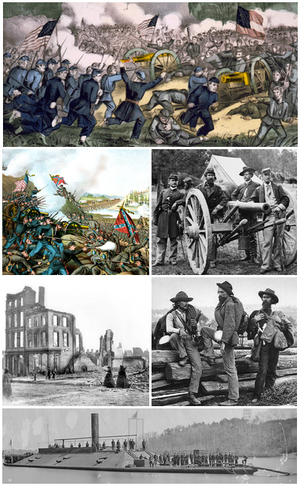American Civil War
1861–1865 conflict in the United States / From Wikipedia, the free encyclopedia
Dear Wikiwand AI, let's keep it short by simply answering these key questions:
Can you list the top facts and stats about American Civil War?
Summarize this article for a 10 years old
The American Civil War (April 12, 1861 – May 26, 1865; also known by other names) was a civil war in the United States between the Union[lower-alpha 5] ("the North") and the Confederacy ("the South"), formed by states that had seceded from it. The cause of the war was the dispute over whether slavery would be permitted to expand into the western territories, leading to more slave states, or be prevented from doing so, which many believed would place slavery on a course of ultimate extinction.
| American Civil War | |||||||||
|---|---|---|---|---|---|---|---|---|---|
 Clockwise from top: | |||||||||
| |||||||||
| Belligerents | |||||||||
|
|
| ||||||||
| Commanders and leaders | |||||||||
|
and others... |
and others... | ||||||||
| Strength | |||||||||
|
2,200,000[lower-alpha 2] 698,000 (peak)[3][4] |
750,000–1,000,000[lower-alpha 2][5] 360,000 (peak)[3][6] | ||||||||
| Casualties and losses | |||||||||
| Total: 828,000+ casualties |
290,000+ total dead
| ||||||||
Theaters of the American Civil War | |
|---|---|
| This article is part of a series on the | ||||||||||||||||||||||||||||||||||||||||||||||||||||||||||||||||||
| History of the United States | ||||||||||||||||||||||||||||||||||||||||||||||||||||||||||||||||||
|---|---|---|---|---|---|---|---|---|---|---|---|---|---|---|---|---|---|---|---|---|---|---|---|---|---|---|---|---|---|---|---|---|---|---|---|---|---|---|---|---|---|---|---|---|---|---|---|---|---|---|---|---|---|---|---|---|---|---|---|---|---|---|---|---|---|---|
 | ||||||||||||||||||||||||||||||||||||||||||||||||||||||||||||||||||
|
||||||||||||||||||||||||||||||||||||||||||||||||||||||||||||||||||
Decades of political controversy over slavery were brought to a head by the victory in the 1860 U.S. presidential election of Abraham Lincoln, who opposed slavery's expansion into the western territories. Seven southern slave states responded to Lincoln's victory by seceding from the United States and forming the Confederacy. The Confederacy seized U.S. forts and other federal assets within their borders. Four more southern states seceded after the war began and, led by Confederate President Jefferson Davis, the Confederacy asserted control over about a third of the U.S. population in eleven states. Four years of intense combat, mostly in the South, ensued.
During 1861–1862 in the Western Theater, the Union made significant permanent gains—though in the Eastern Theater the conflict was inconclusive. The abolition of slavery became a Union war goal on January 1, 1863, when Lincoln issued the Emancipation Proclamation, which declared all slaves in states in rebellion to be free, applying to more than 3.5 million of the 4 million enslaved people in the country. To the west, the Union destroyed the Confederacy's river navy by the summer of 1862, then much of its western armies, and seized New Orleans. The successful 1863 Union siege of Vicksburg split the Confederacy in two at the Mississippi River. In 1863, Confederate General Robert E. Lee's incursion north ended at the Battle of Gettysburg. Western successes led to General Ulysses S. Grant's command of all Union armies in 1864. Inflicting an ever-tightening naval blockade of Confederate ports, the Union marshaled resources and manpower to attack the Confederacy from all directions. This led to the fall of Atlanta in 1864 to Union General William Tecumseh Sherman, followed by his March to the Sea. The last significant battles raged around the ten-month Siege of Petersburg, gateway to the Confederate capital of Richmond. The Confederates abandoned Richmond, and on April 9, 1865, Lee surrendered to Grant following the Battle of Appomattox Court House, setting in motion the end of the war.
A wave of Confederate surrenders followed. On April 14, just five days after Lee's surrender, Lincoln was assassinated. On May 26, the last military department of the Confederacy, the Department of the Trans-Mississippi, effectively surrendered, but the conclusion of the American Civil War lacks a clear end date, and Appomattox is often symbolically referred to. Small confederate ground forces continued surrendering past the May 26 surrender date until June 23. By the end of the war, much of the South's infrastructure was destroyed, especially its railroads. The Confederacy collapsed, slavery was abolished, and four million enslaved black people were freed. The war-torn nation then entered the Reconstruction era in an attempt to rebuild the country, bring the former Confederate states back into the United States, and grant civil rights to freed slaves.
The Civil War is one of the most extensively studied and written about episodes in U.S. history. It remains the subject of cultural and historiographical debate. Of particular interest is the persisting myth of the Lost Cause of the Confederacy. The American Civil War was among the first wars to use industrial warfare. Railroads, the telegraph, steamships, the ironclad warship, and mass-produced weapons were all widely used during the war. In total, the war left between 620,000 and 750,000 soldiers dead, along with an undetermined number of civilian casualties, making the Civil War the deadliest military conflict in American history.[lower-alpha 6] The technology and brutality of the Civil War foreshadowed the coming World Wars.